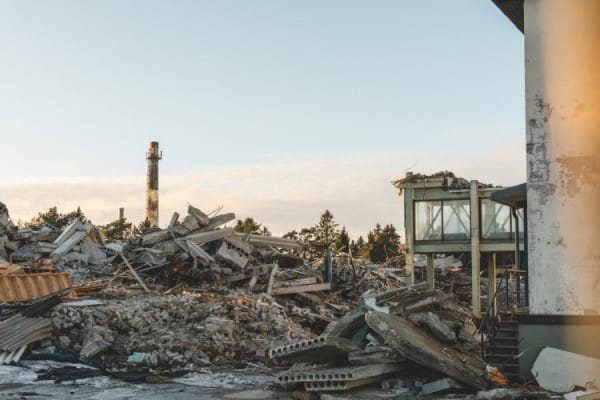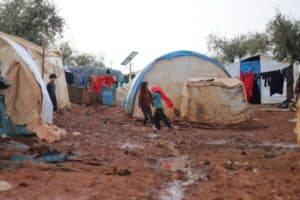We all see events around the world that have had a huge impact on people – think the conflict in Syria, the 2010 Haiti earthquake or the 2013 Typhoon Haiyan in the Philippines. We often hear these events characterised as humanitarian emergencies. But what actually makes something we see on the news a humanitarian emergency?
A humanitarian emergency is a large-scale event that has a significant impact including loss of life, injury and damage to property, that requires an urgent aid response. A humanitarian emergency happens when a vulnerable population is hit with an event they cannot recover from themselves.
Now we’ve given the definition, let’s fully breakdown what a humanitarian emergency consists of…
Humanitarian Emergencies: An Overview
A humanitarian emergency is a large scale, sudden event that impacts of a significant number of people. It involves extensive lose of life, injury, damage to property and infrastructure and removal of livelihoods. A humanitarian emergency happens suddenly, requiring urgent responses and is often characterised as being ‘rapid onset’.
Humanitarian emergencies are caused when events that can have a negative impact on human lives, such as earthquakes, floods, famines or conflicts, occur in an area where people are vulnerable to its effects. In order to be characterised as a humanitarian emergency there also needs to be an urgent and sudden need to respond.
The negative event, plus the vulnerability, plus the urgent need to respond is what results in a humanitarian emergency.
Let’s break it down. For example, they have earthquakes in Japan. However, Japan has designed much of their infrastructure to withstand earthquakes and so, although the event with the potential for negative impacts on people, because areas of Japan are not vulnerable, no humanitarian emergency happens.
On the other hand, when an earthquake happens in Nepal, as it did in 2015, a humanitarian emergency did occur. This is because Nepal and its people have a significant vulnerability to the impact of an earthquake and so there was large loss of life, injury and damage to property and infrastructure. There was also an urgent need to respond as the earthquake occurred suddenly and a rapid response was required.
As we can see, a humanitarian crisis only happens when a sudden big event hits a lot of people who are vulnerable to its consequences and urgent assistance is needed.
What Makes A Humanitarian Emergency?
A humanitarian emergency requires the mobilisation of civilian, military, political and non-governmental organisations to urgently assist people affected. As large numbers of people are suddenly affected by events that overcome their resilience, such as a typhoon affecting a poorer community with lower quality housing, people become in need of assistance. A humanitarian emergency is then declared.
When this happens on a massive scale, such as the 2010 Haiti earthquake, the Indian Ocean earthquake and tsunami in 2004 or the 2013 Pakistan floods, the local structure designed to help people, such as the government agencies, are unable to cope. In this case international assistance may be called upon.
Sudden massive events such as these that require urgent relief assistance are characterised as humanitarian emergencies.
There are many are many ways that a humanitarian emergency may be responded to, and not all humanitarian emergencies require international assistance. Depending on the impact that the affected population has had, civilian, government, military or NGO actors may respond with shelter provision, food, protection, livelihood assistance or financial aid.
Types of Humanitarian Emergencies
There are many events that can be humanitarian crises. These can be broken down into two main types.
Natural Disasters
Humanitarian emergencies that are natural disasters include events such as:
- Earthquakes
- Floods
- Cyclone/Typhoons
- Pandemics
- Tsunamis
These humanitarian emergencies are caused by naturally occurring events happening in an area where people are vulnerable to their impact, combined with an urgent need for humanitarian assistance.
As countries and populations become more resilient to natural disasters, these types of humanitarian emergencies become less common. For example, improvements to early warning systems, storm defences and better housing and infrastructure in Taiwan has limited the impact of typhoons there. As a result, events that can be classified as a humanitarian emergency don’t really happen in Taiwan, even though they can be hit by typhoons.
On the other hand, in places such as Bangladesh, people are more vulnerable to the impacts of extreme weather events which cause more damage to homes and property and greater loss of life. As a result, a storm hitting Bangladesh may cause a humanitarian emergency if it results in large number of people needing urgent assistance as they do not have the resilience that they have in Taiwan.
No matter how resilient to negative events a population may seem, a significant event can still cause a humanitarian energy. An example of this is the Fukushima disaster in Japan. Japan has some of the best infrastructure protecting against the impacts of earthquakes, flood and nuclear meltdowns. However, the tsunami that hit in 2011 was so huge it overcame these defences and still resulted in a humanitarian emergency.
Man-Made
The other type of humanitarian emergencies is man-made. These are negative events that are caused by humans that result in significant negative impacts of large numbers of people and require a rapid response. Examples of man-made humanitarian emergencies can be:
- Conflicts
- Human displacement
- Economic crises
- Fires
Although these events are caused by the actions of people, their classification as humanitarian emergencies is the same as for naturally occurring events. Essentially, a man-made event has occurred, such as a war, that has encountered people without the resilience to withstand its negative impact, and urgent humanitarian assistance is required.
Like natural disasters, man-made humanitarian emergencies have large-scale negative impacts on lots of people, including significant death, injury, damage to homes and infrastructure and loss of people livelihoods.
Humanitarian Emergency vs Humanitarian Crises
The terms humanitarian emergency and humanitarian crises are often used interchangeably. However, they do have slightly different meanings.
Both a humanitarian emergency and a humanitarian crisis are large-scale events that negatively impact many people causing loss of life, injury and damage. The difference is a humanitarian emergency requires a rapid response and is often an unexpected event. Whereas a humanitarian crisis is more of an umbrella term also covering a large range of longer-term events.
Humanitarian workers will often use the phrases ‘rapid-onset’ to describe a humanitarian emergency. This is because a humanitarian emergency usually occurs suddenly, such as earthquakes, tsunamis or cyclones.
Humanitarian crises, on the other hand, usually describes longer terms events that build-up, such as conflicts or pandemics.
Importantly, most humanitarian crises begin with or contain a humanitarian emergency, such as at the beginning of an armed conflict or the peak of an economic crises. The important difference between a humanitarian emergency and a humanitarian crisis is the speed in which the response is needed.
Although humanitarian crises obviously mean people require assistance, the term humanitarian emergency is used when a sudden large-scale event requires an urgent mobilisation of response resources.





